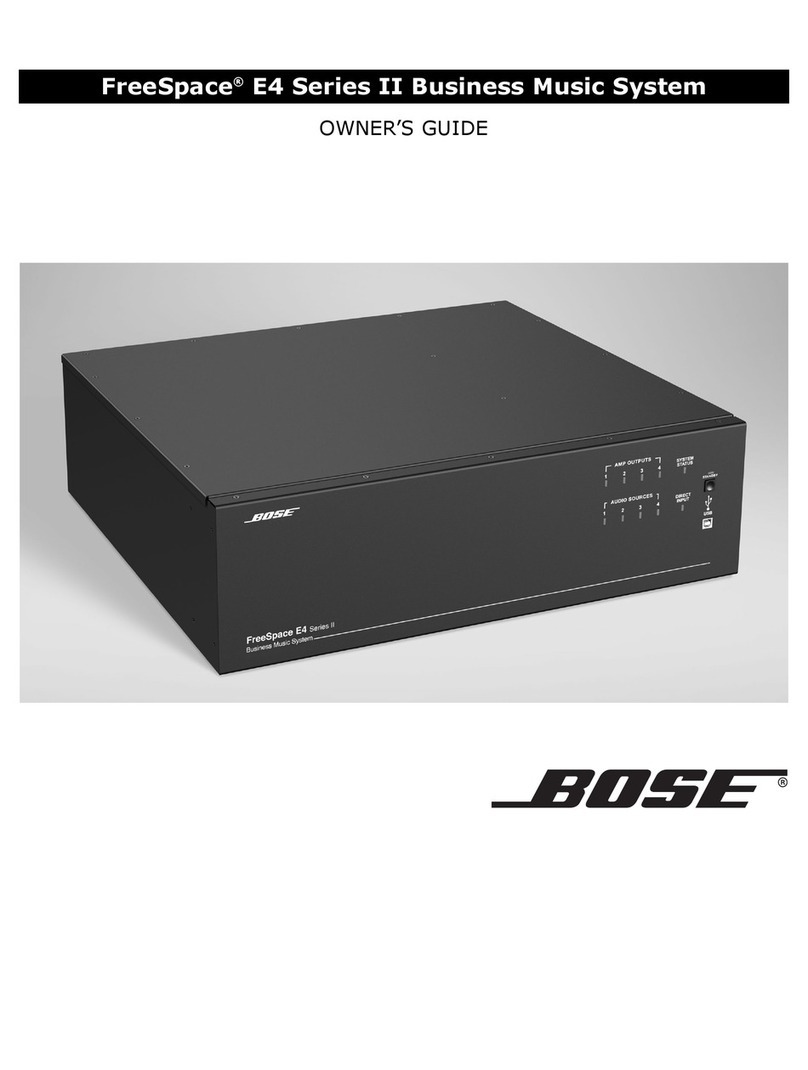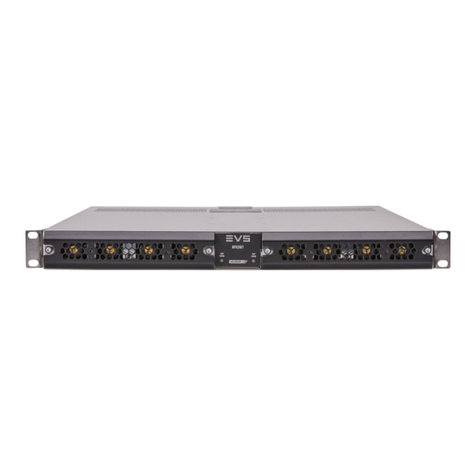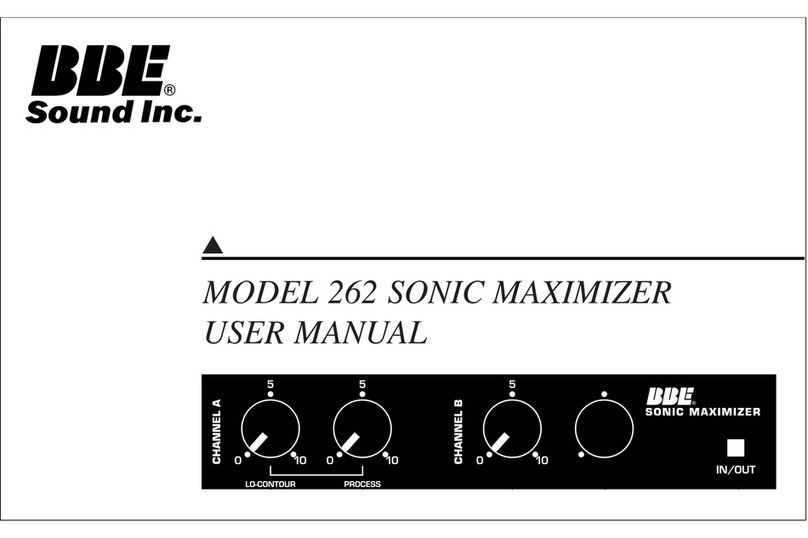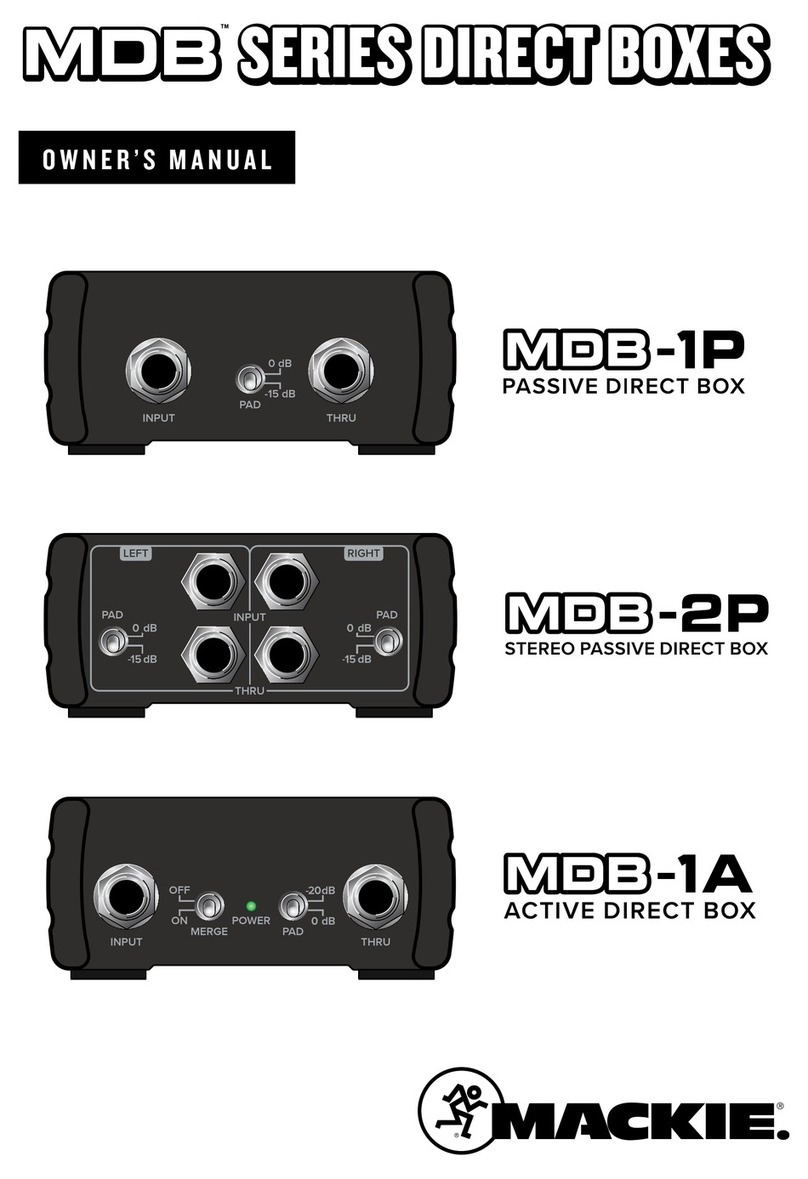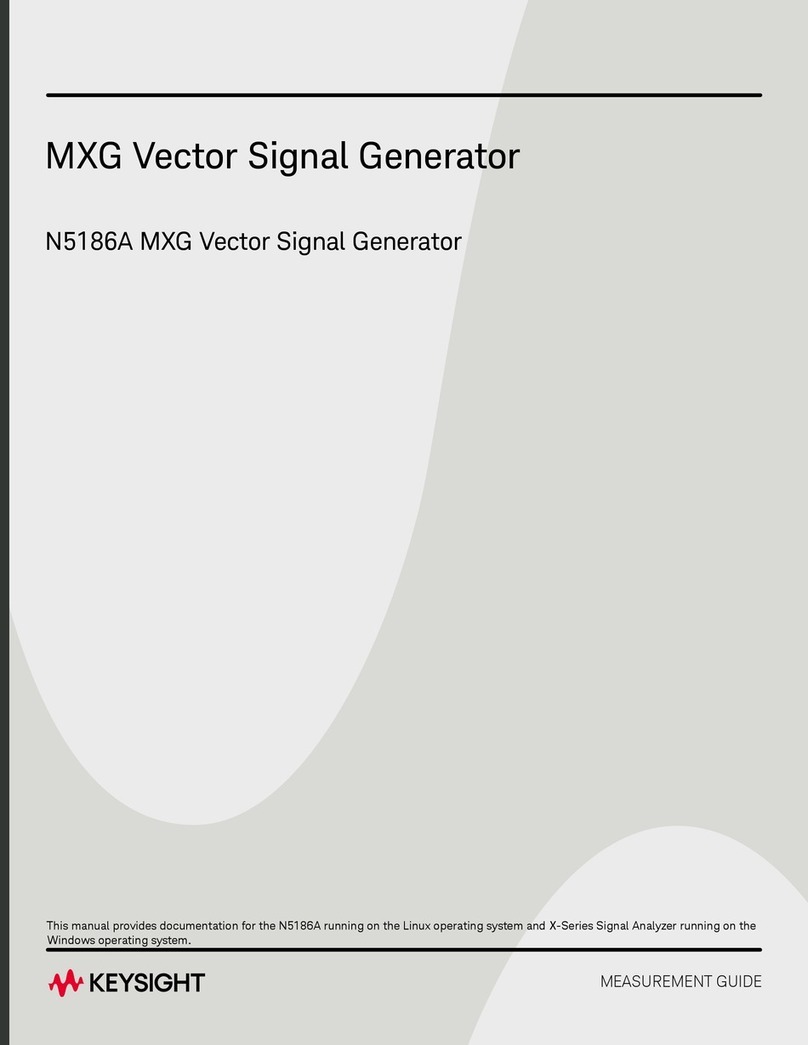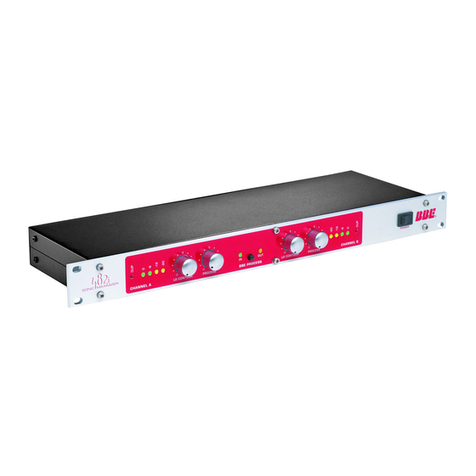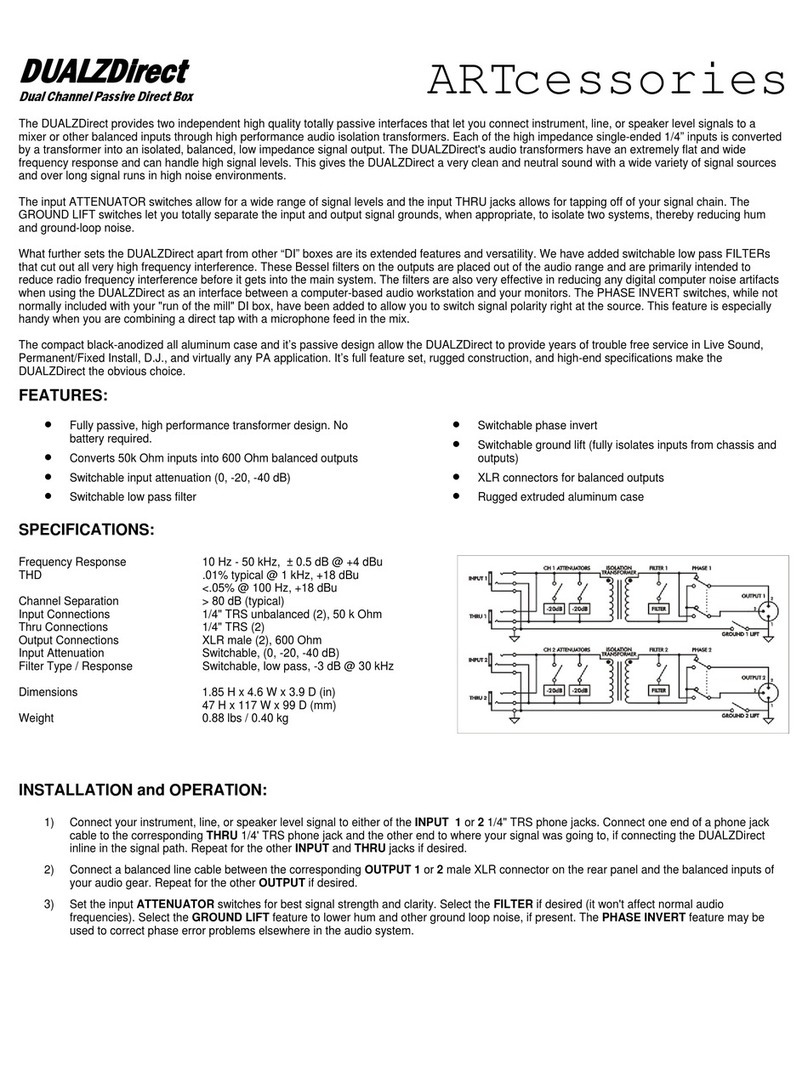RoentDek CFD8c User manual

RoentDek
HandelsGmbH
Supersonic Gas Jets
Detection Techniques
Data Acquisition Systems
Multifragment Imaging Systems
The RoentDek Constant Fraction Discriminators
CFD8c, CFD7x, CFD4c, CFD1c and CFD1x
(11.0.1701.1)

Page 2 of 25 The Constant Fraction Discriminators CFD8c, CFD7x, CFD4c, CFD1c and CFD1x (11.0.1701.1)
Mail Addresses:
Headquarter
RoentDek Handels GmbH
Im Vogelshaag 8
D-65779 Kelkheim-Ruppertshain
Germany
Frankfurt branch
RoentDek Handels GmbH
c/o Institut für Kernphysik
Max-von-Laue-Str. 1
D-60438 Frankfurt am Main
Germany
Web-Site:
www.roentdek.com
WEEE:
DE48573152
Product names used in this publication are for identification purposes only and may be trademarks of their respective companies.
All rights reserved. Technical changes may be made without prior notice. The figures are not binding.
We make no representations or warranties with respect to the accuracy or completeness of the contents of this publication

The Constant Fraction Discriminators CFD8c, CFD7x, CFD4c, CFD1c and CFD1x (11.0.1701.1) Page 3 of 25
Table of Contents
3B. THE CFD TIMING DISCRIMINATOR MODULES.........................................................................................6
3B.1 GENERAL DESCRIPTION .........................................................................................................................................6
3B.2 PRINCIPLES OF THE CFD CIRCUIT..........................................................................................................................8
3B.3 ADJUSTING THE CFD PARAMETER.........................................................................................................................9
3b.3.1 Threshold level............................................................................................................................................ 10
3b.3.2 CFD delay................................................................................................................................................... 11
3b.3.3 CFD fraction...............................................................................................................................................12
3b.3.4 Walk level....................................................................................................................................................13
3b.3.5 Output signal width.....................................................................................................................................14
3B.4 THE VETO OPTION ............................................................................................................................................... 14
3b.4.1 Accessing the jumpers in CFD1c / CFD1x.................................................................................................16
3b.4.2 Accessing the jumpers in CFD8c and CFD7x ............................................................................................16
3b.4.3 Accessing the jumpers in CFD4c................................................................................................................17
3B.5 PERFORMANCE LIMITATIONS ...............................................................................................................................18
3b.5.1 Temperature drift........................................................................................................................................18
3b.5.2 Pre-trigger problem.................................................................................................................................... 18
3b.5.3 Cross talk problem......................................................................................................................................19
3B.6 THE CFDX PULSE HEIGHT DETERMINATION OPTION ............................................................................................19
3B.7 THE BCFD VERSION OF READ-OUT OF BIPOLAR INPUT SIGNALS...........................................................................22
LIST OF FIGURES..........................................................................................................................................................24
LIST OF EQUATIONS....................................................................................................................................................25

Page 4 of 25 The Constant Fraction Discriminators CFD8c, CFD7x, CFD4c, CFD1c and CFD1x (11.0.1701.1)

Constant Fraction DiscriminatorsCFD8b, CFD4b and CFD1b (11.0.1701.1) Page 5 of 25

Page 6 of 25 The Constant Fraction Discriminators CFD8c, CFD7x, CFD4c, CFD1c and CFD1x (11.0.1701.1)
3b. The CFD timing discriminator Modules
The RoentDek CFD (Constant Fraction Discriminator) units can be used for improving the timing response of electronic
signals, e.g. as obtained from secondary electron multipliers like MCPs, Photomultipliers, Channeltrons or similar avalanche
counters.
Figure 3.1b: The CFD8 (here: CFD8b version), CFD7x similar
Especially for advanced RoentDek detectors with Hexanode (Hex75/Hex100) the combination of the RoentDek
FAMP amplifiers and these CFD units has considerable advantage over the RoentDek ATR19 modules in terms of pulse-
pair resolution and timing precision. Using the RoentDek CFDs is recommended for LC-delay-line anode (DLD40X or
RS-PMT25/40) and may also improve the performance of the RoentDek DLD or DET MCP detectors.
It has to be noted that any operational improvement over the easy-to-use ATR19 units requires a detailed understanding of
the CFD function and a proper setting of the CFD parameters. The RoentDek CFD units allow a precise adjustment of all
these parameters to different input signal properties (e.g. rise time) and their control by two types of monitor outputs for
achieving optimal timing results. Following the description here is mandatory for successful use.
This manual describes the latest product series CFD8c/4c/1c and CFD1x/7x.which are part of the RoentDek
FEE2/5/7x/8frontend electronics assemblies. Units with earlier version numbers (b or a) are very similar and this manual
may serve as a reference, too. However, the older product versions have fewer features (e.g. no veto option) and can differ in
power requirements, positions of control elements and output options. You may request an older manual version from
RoentDek for those devices.
All CFD units (except for the “x” channels) can be equipped with boards to operate bipolar signals as from the RoentDek
bFAMP modules. If you have received CFD modules containing such boards please review first Chapters 3b.1 to 3b.3 and
then refer to Chapter 3b.7 to learn about the difference between the standard CFD and the RoentDek bCFD settings.
3b.1General description
If a source produces signals with different pulse heights, a simple comparator circuit or leading-edge discriminator unit will
produce a digital output signal with a time jitter on the order of the input signal’s rise time, thus limiting the achievable timing
precision.
The CFD circuit was designed to deliver a “digital” output signal (e.g. NIM) with timing properties almost independent from
the pulse height for all signals above a selectable threshold level. If the CFD is properly adjusted to the input signal’s
properties, the jitter of this digital “timing output” signal can be reduced by at least a factor of 100 compared to leading-edge
discrimination, as long as the pulses are fairly above noise and the normalized input signal width (the FWHM) does not vary as
function of pulse height. The RoentDek CFD units have a bandwidth of about 300 MHz, require negative input signals
on the In socket and provide 3 such timing outputs as NIM signals from sockets labelled NIM-Out on the front panel. Some
units are available with additional ECL outputs on request or TTL output (CFD1c only). The input signal pulse height should
not exceed -2 V and there is no good temporal resolution to expect for signals smaller than -100 mV. If signals or levels >
2 V or smaller -2 V are connected to the CFD input the circuit can be damaged. For operation with signals beyond the
safe range RoentDek can supply passive attenuators or inverter plugs (pAtt and pInv).
RoentDek offers three different case versions hosting 8(7), 4 or 1 CFD channels, some with pulse height determination
option (CFDx) on one of the channels.
The CFD8c (see Figure 3.1b) is a standalone unit with 8 independent channels. In the version CFD7x one channel is replaced
by a circuit allowing for a pulse height determination on one channel. These units are the recommended versions for operating
RoentDek Hexanode Delay-line detectors. The CFD8c/7x are standalone modules for 19” racks (one height unit) and

The Constant Fraction Discriminators CFD8c, CFD7x, CFD4c, CFD1c and CFD1x (11.0.1701.1) Page 7 of 25
come with an external mains adapter for 100-250 V AC (50-60 Hz). The power consumption is
max. 3.7 A at 12 V DC (<45 W). The case size is (approx.): 485 mm x 45 mm x 375 mm (width x
height x depth incl. power connector), weighing: 2.5 kg (without 12 V power adapter)
The single-channel units CFD1c and CFD1x (version with pulse height determination circuit) come
in a stand-alone 3HU case (W61 mm/L129 mm/H232 mm, weight 0.8 kg) with an external
12 V DC mains adapter for use with 100-250 V AC sockets. The power consumption is max. 0.5 A
at 12 V DC (6 W) or max. 0.7 A at 12 V DC (<10 W) for the CFD1x.
The CFD4c has the same functions as the CFD8c for 4 channel operation in a 1/12 NIM cassette
(W34 mm/L280 mm/H220 mm, weight 1.2 kg) and requires a NIM-bin for operation: The current
drawn is max. 0.2 A from the 6 V line and -1.8 A from - 6 V*.
Figure 3.2b: Photos of the CFD4 and CFD1 series cases (here: ‘b’ versions) and the SPS3 power supply
*The CFD4c can optionally be ordered with a 9-pin sub D input for external +6 V/-6 V/-5.2 V powering via the SPS3 mains
adapter. The SPS3 is also required for the older CFD1b model.

Page 8 of 25 The Constant Fraction Discriminators CFD8c, CFD7x, CFD4c, CFD1c and CFD1x (11.0.1701.1)
3b.2Principles of the CFD circuit
It is important to note that an optimal operation of the RoentDek CFD units requires optimal settings of the parameters
•Threshold level (Th)
•Walk level (Z)
•CFD delay
•CFD fraction
with respect to the input signal properties. This will be explained in the following.
Figure 3.3b: Front panel inputs, test points and control potentiometers , not shown is the veto input
and the
CFD fraction
potentiometer being on the front panel for c and x versions (see Figure 3.14)
If a signal as shown in Figure 3.4b (left)*is turned into a bipolar signal (right) by an appropriate electronic chain it can be
shown that the zero-crossing of the bipolar signal does not jitter in time as function of the input pulse height.
The CFD circuit consists of two parts:
The “
analogue
”
circuit
produces this bipolar signal from a unipolar input signal: A resistor-divider splits the signal into two
with different relative pulse heights. The ratio of the pulse heights (
CFD fraction
) is determined by the choice of fix resistors
or a potentiometer (as in case of the RoentDek CFDs). While one of the signals is inverted later on, the other experiences a
certain delay (
CFD delay
) before both signals are superimposed to form the bipolar signal. On the RoentDek CFDs, this
delay is formed by an external coax cable (LEMO 00 series) connected between the front-panel sockets labelled Delay. The
bipolar signal can be observed on the analogue walk monitor output socket labelled Ma(damped by a factor of 10). The CFD
fraction can be adjusted via a potentiometer on the front panel side panel (CFD4b: side panel, CFD1b and CFD8b: on the lid).
Figure 3.4b: Schematics of a CFD analogue chain
Figure 3.6b shows the digital circuit chain of two comparators and a logical AND-gate: One comparator switches to “high”
when the input signal exceeds a certain (adjustable) reference value (the
Threshold level)
and produces a norm signal (this is
how a simple “leading-edge” discriminator unit operates). When the input signal level is below the Threshold level, its output
returns to “low”. Ideally, the Threshold level is set above electronic noise but low enough to register even the smallest valid input
signals.
*Note that for RoentDek CFDs the input signal polarity is negative

The Constant Fraction Discriminators CFD8c, CFD7x, CFD4c, CFD1c and CFD1x (11.0.1701.1) Page 9 of 25
A second so-called “walk comparator” in the circuit operates in the
same way with the bipolar signal. Its reference, the
Walk level
, shall
be set very near and slightly above the baseline level of the input
signal so that it “triggers in the noise”. Then the bipolar signal
produces a distinct series of transitions as the noise fluctuates around
this level (see Figure 3.6b). In presence of a significant input signal a
certain transition from “low” to “high” represents the zero-crossing
of the bipolar signal (the “timing transition”) which shall serve as the
accurate timing output of the CFD circuit. This signal is produced by
a logic AND-gate of the two comparator outputs.
The RoentDek CFDs allow monitoring the output of the walk
comparator via the digital monitor output socket labelled Md.*
The Threshold level and the Walk level can be set via two potentiometers labelled Th and Z (Z standing for Zero Crossing Level)
with corresponding test points to measure the actual levels with a voltmeter. A ground reference point labelled GND is
provided on the front panel of most units. The width of the CFD timing output signals is adjustable via a potentiometer
labelled Won the front panel. The width can be increased by a factor of 10 by placing a jumper on the dedicated position
through a hole in the side panel (CFD8/7x: top lid) for each channel individually.
Note that the test points can only give coarse information about the setting (within about ±5 mV). For optimal results and
adjustment, the signals have to be verified on an oscilloscope. The CFD Fraction can be adjusted by another potentiometer
labelled Fr on the front panel (CFD4b, CFD1b: side panel, CFD8b: top lid (see Figure 3.6b). Figure 3.6b also shows the
position of the jumper terminal for increasing the timing signal output width
The RoentDek CFD is useful for signals with rise/fall time > 1 ns. If the input signal source has less than 3 ns FWHM the
CFD might not operate optimally even with small CFD delay and optimized settings of the fraction (see below). The input
signal heights should be kept between 50 mV and -2 V (on 50 Ω impedance) by selecting a proper gain on the given amplifier.
The input should not be exposed to signals higher than -3 V or DC levels higher than ±1 V.
The oscilloscope traces in the next chapter are shown as examples for optimal parameter settings and the effect of changing a
certain parameter.
3b.3Adjusting the CFD parameter
Figure 3.7b shows all relevant signals with a near-optimal adjustment of the parameters Threshold level, Walk level, CFD delay and
CFD fraction for a given input signal of about 5 ns rise time (upper trace). The traces trigger on the negative slope of the lowest
trace, which is the CFD timing output. The analogue and digital walk monitor outputs are displayed on the second and third
trace. The CFD fraction was set to 0.35 (default) and cable produces 4 ns external delay which results in an effective CFD delay
of about 4.5 ns, i.e. sightly increased by internal delays on the circuit board).
*Note the Mdoutput has a DC offset of about -0.1 V
Figure 3.6b: Schematics of the
CFD digital circuit chain
Figure 3.5b: top/side panel with fraction
potentiometer only versions a/b) and optional
jumper terminal for increasing the CFD output
width by a factor of 10 (optional)

Page 10 of 25 The Constant Fraction Discriminators CFD8c, CFD7x, CFD4c, CFD1c and CFD1x (11.0.1701.1)
Figure 3.7b: Oscilloscope traces of in- and output signals of the CFD, traces 1-4 from top: input signal, analogue
monitor output signal, digital monitor output signal, CFD timing output signal (which triggers all traces). The red
arrows indicate the
timing transition
which appears slightly shifted in the different traces due to internal delays.
This and the following images of signal traces have been obtained with a 300 MHz analogue oscilloscope (a large
number of signals with varying pulse heights are superimposed). Similar views can be obtained from digital
oscilloscopes with adequate “persistence” setting
The Threshold level (see below) was set so that even the smaller signals from the pulse height distribution are registered. This can
be verified both on the first trace (input signal) and on the analogue monitor output (trace 2). The input signal cannot always
be displayed together with the CFD outputs unless the signal source (e.g. amplifier) has two independent outputs sockets.
Therefore the trace of the signal input was omitted on the next figures. The analogue walk monitor may serve as well for
verifying the threshold level but it is to note that the analogue walk monitor signal height is damped by a factor of 10.
For achieving the ideal settings it is first of all important to note that the CFD operates best (in all respects) and yields the
optimal temporal resolution if the input signals are as high as possible but only up to -2 V. The threshold should not be set
smaller than 50 mV for the multi-channel versions because then there is a risk of inter-channel cross talk (see Chapter 3b.5.3).
Please note that it is preferable to obtain such high signals rather by a low amplifier gain but high “raw” signal from the given
detector (e.g. high gain on the physical electron multiplier MCP, PMT, Channeltron …) if one has this choice. This can for
example be achieved by increasing the bias voltage on the physical electron multiplier.
For a given electronic noise level, signal-to-noise ratio can only be improved by increasing the gain of the primary charge input
from the detector source to the electronics. Only then signals have optimal signal-to-noise ratio which will finally determine
achievable resolution.
3b.3.1
Threshold level
The Threshold level shall be set just above the input signal line’s noise level. This can be verified by observing the CFD output
simultaneously with the analogue walk output on an oscilloscope as shown in Figure 3.8b.
If the threshold is set too high, small (but valid) signals are not registered (see Figure 3.8b, left picture), if it is set too low (right
picture), the CFD output will also trigger on spurious noise components and produce background counts.

The Constant Fraction Discriminators CFD8c, CFD7x, CFD4c, CFD1c and CFD1x (11.0.1701.1) Page 11 of 25
:
Rule for Delay
Figure 3.8b: Signal traces similar as in Figure 3.7b for poorly adjusted
Threshold level:
analogue monitor output,
digital monitor output (only in left picture) and CFD output. Left picture: for too high threshold settings only input
signals with very high amplitudes are registered. When setting the correct Threshold level, the dark area shown by
the arrow would be filled with smaller amplitude signals. Right picture: threshold setting too low (i.e. in the noise)
Sometimes it is necessary to compromise and allow a certain amount of noise triggers in situations where the noise level is not
well separated from the signals. This is acceptable if the random signals do not affect the measurement and their rate does not
exhaust the data acquisition capability of circuits in follow-up electronics (e.g. a TDC or TAC). If the threshold is set too high,
signals are lost.
3b.3.2
CFD delay
The CFD delay must correspond to the input signal rise time and is set by bridging the “Delay”-sockets with an appropriate
cable (LEMO 00 series). As a thumb rule, a 1m long coax cable will produce an external delay of 5 ns. It is to note that the
RoentDek CFDs have an additional internal offset delay of about 0.5 ns. A 1 m (5 ns) external delay cable thus results in a
total delay D of 5.5 ns. Note, that the RoentDek CFDs will not operate without connecting an external delay cable bridge.
If the pulse rise time RT is defined as the time from reaching 10% to 90% of the signal maximum, the delay shall be equal or
smaller (50-80%) than this rise time RT, depending on the CFD fraction ratio f. For small CFD fractions (< 0.5) a thumb rule for
an appropriate delay D is
D = RT (1-f)
However, a delay D < ½ RT is not recommended even for CFD fractions higher than 0.5.
If a RoentDek CFD is delivered as part of a detector system, appropriate cables are usually included. Cables with 1-3 ns
delay shall be used for the MCP timing signal and cables with 4 or 5 ns delay are recommended for the delay-line signals (10 ns
in case of LC-delay-line anodes). Sometimes, especially for large-size detectors it may be of advantage to use longer delay
cables.
The input pulses in Figure 3.7b have about 6 ns rise time, the chosen cable delay results in a CFD delay of 4.5 ns, which is
close enough to the optimal value of 4 ns for the selected CFD fraction of 0.35. If the delay cable is too long, the two
intermediate signals (inverted/delayed, respectively) do not merge into a “proper” bipolar signal (see Figure 3.9b left). If the
delay cable is too short, no distinct cross over is formed from the intermediate signals (see Figure 3.9b right). The CFD cannot
function properly under any such CFD delay settings. A non-perfect choice of delay can sometimes be compensated by
adjusting the CFD fraction (see below) as long as D/RT is between 0.5 and 1 (see Figure 3.10b).
Equation 3.1
b

Page 12 of 25 The Constant Fraction Discriminators CFD8c, CFD7x, CFD4c, CFD1c and CFD1x (11.0.1701.1)
Figure 3.9b: Signal traces (as in Figure 3.8b left) but with too long (left picture) and too short delay cable (right)
Figure 3.10b: Signal traces (as in Figure 3.8b left) with a too short delay cable (left picture). This can fairly be
compensated by increasing the CFD fraction from 0.35 to 0.6 (right picture)
3b.3.3
CFD fraction
Optimal choice of the CFD fraction ratio is as important as the appropriate selection of the CFD delay and is linked to it
according to the above guide lines. Ideally, these two parameter settings will result in a bipolar signal in such a way that the
zero-crossing happens with the maximum possible slope. Although this depends on the exact shape of the signal a
CFD fraction ratio between 0.3 and 0.45 will give optimal results for near-Gaussian shaped input signals (only the rising edge is
relevant). RoentDek delivers the CFD with a standard CFD fraction setting of about 0.35. The CFD fraction can be varied
between 0.15 and 1 via a potentiometer.
In order to observe and quantify the CFD fraction ratio on the oscilloscope one can use a very long delay cable and estimate the
relative pulse heights when the signal portions appear distinct as in Figure 3.9b left (comparing positive and negative signal
height).
Under certain experimental conditions it may be beneficial choosing a higher or lower CFD fraction ratio than the default value.
CFD fractions smaller than 0.3 should generally only be set for high signal-to-noise ratio. Then a low CFD fraction can be of
advantage in case of non-linear amplification of the input signals (e.g. presence of saturation effects in the amplifier before the
CFD) or in case of varying relative signal width (FWHM) as function of pulse height. Low fraction values may also improve
the temporal resolution for very short signals (< 3 ns FWHM). Furthermore, choosing a very short delay cable (i.e. 0.5 ns) in
combination with a high Walk level can force the CFD into the operation mode of a leading edge discriminator.

The Constant Fraction Discriminators CFD8c, CFD7x, CFD4c, CFD1c and CFD1x (11.0.1701.1) Page 13 of 25
Higher CFD fraction (up to 0.8) is recommended for multi-hit operation, especially if the input signals show overshoot or
ringing patterns: The timing of later signals in the “ringing noise” from an earlier signal will be less affected if a high
CFD fraction is chosen.
Figure 3.11b: Signal traces (as in Figure 3.8b left) with different CFD fractions: left picture f = 0.35, right: f = 0.7
3b.3.4
Walk level
For optimal timing resolution the Walk level must be very near the baseline of the input signals which corresponds also to the
baseline of the bipolar signal from Maoutput. To achieve this, at first the Z-potentiometer should be tuned until about 0 V can
be measured at the corresponding test point. Now the digital walk monitor (Md) shows one distinct transition from “high” (-
0.2 V) to “low” (-0.1 V) during the bipolar signal’s crossover, while fluctuating almost equally between “high” and “low” states
before and long after the signal, due to electronic noise on the line (not visible in the pictures). If the Walk level is perfectly set
to the input signal’s baseline, the output signal from the digital monitor (Md) is as often in the “high” state as in the “low”
state. This can be judged from an equal intensity (“brightness”) of the trace before the main transition signal in the two
possible states (see Figure 3.12b, left picture). Usually, the relative brightness before and immediately after the timing
transition are not the same. This is due to signal reflections and ringing following the input signal. Therefore, the intensities
before or long after (> few hundred ns) the timing transition should be compared.
Figure 3.12b: Signal traces (as in Figure 3.8b left) with the walk level set to the baseline of the input signals
(left picture) and slightly towards the positive side where the noise triggers begin to vanish
(right picture), leading to slightly less intensity in the area right of the arrow.

Page 14 of 25 The Constant Fraction Discriminators CFD8c, CFD7x, CFD4c, CFD1c and CFD1x (11.0.1701.1)
The Walk level shall now be adjusted to the input signal DC level by fine-tuning the Z-potentiometer. In theory, optimal
temporal resolution is achieved if the walk level is exactly set to the baseline of the signal, indicated by equal abundance of
“high” and “low” states from noise fluctuation just before the input signal appears.
Under “real” experimental conditions it turns out to be “safer” if the Walk level is slightly positive, i.e. so high that the trace
brightness in the “high” state (before the timing transition) begins to disappear (see Figure 3.12b, right picture). This setting is
less likely to produce false “noise triggers” (see “Pre-trigger problem”) and usually does not affect the effective temporal
resolution significantly. This is especially important if the initial Walk level adjustment is done at low signal rate but the rate
increases as experimental conditions change (see below).
If the Walk level is set too far from the input signal’s baseline (see Figure 3.13b) the time resolution will be less than optimal.
Especially in case of a far too low Walk level, the CFD may not work properly at all, while a too high Walk level will turn the
CFD more and more into a leading edge discriminator.
Figure 3.13b: Signal traces (as in Figure 3.8b left) with the Walk level
set too low (left picture) and too high (right picture)
3b.3.5
Output signal width
The CFD output signal width can be adjusted between 4 ns and 200 ns with the W-potentiometer on the front panel if no
jumper is placed (default) on the “width bridges” of the internal circuit (see Figure 3.5b). With the jumper in place, the
maximum width is increased to 2000 ns. Please contact RoentDek if you are in need of the optional jumpers.
Obviously, a small output signal width is necessary for a high pulse-pair resolution (multi-hit operation). The multi-hit dead-
time depends thus on the output signal width but also on the rise time of the input signal and the CFD settings. For optimized
setting and small input signal rise time, the multi-hit dead-time can be as low as 10 ns. It may be, however, that the timing of a
later signal is affected by ringing tails from an earlier particle. In case of very small CFD output signal width it has to be
verified that the follow-up electronics can handle such short signal.
Larger output widths can be beneficial to reduce “false” trigger signals from delayed ringing or reflection signals following the
main input signal (as long as a small pulse-pair dead time is not required). The trailing edge of the output signal can (as the
rising edge) produce time cross talk between channels (see “time cross talk problem”), therefore a variation of the width may
be used to move the trailing edge out of the time range of interest where it could give rise to time cross talk.
3b.4The Veto option
The c and x series of the RoentDek CFD modules feature a “Veto” and “Gating” (anti-Veto) function. It allows to disable
or enable timing outputs of from the unit as a function of the voltage level on the input socket labelled Veto which is switched
between 0 V (“low”) and “high”: -0.8 V (50 Ohm input impedance)*. The logic (enable or disable) can be set by internal
jumpers, individually for each channel. There are three modes of operation:
*Safe values for “low” are levels between -0.1V and +0.1V, for “high” -0.7V to -1V (on 50 Ohm impedance coax input)

The Constant Fraction Discriminators CFD8c, CFD7x, CFD4c, CFD1c and CFD1x (11.0.1701.1) Page 15 of 25
Figure 3.14b: Position of Veto input socket on the CFD8c front panel. For the CFD4c it is found on the rear panel
‘Veto’ mode: The CFD timing outputs are disabled while a NIM level (-0.8 V on 50 Ohm) is present on the Veto input.
This is shown in the left picture of Figure 3.15b. This mode is factory-set by default
‘Gating’ mode: The CFD timing outputs are enabled while a NIM level (-0.8 V on 50 Ohm) is present on the Veto input
(see right picture of Figure 3.15b).
‘Neutral’ mode: The CFD timing outputs are independent of the level on the Veto input (i.e. functionality turned off)
Figure 3.15b: Trace of the input signal to the Veto socket (upper trace) and signal traces of CFD
timing signals (lower trace, integrated over many events) for Veto (left) and Gating mode (right)
In order to work reliably, a level transition on the Veto input must be switched at least 10 ns before it can effectively
block/enable the CFD timing outputs. Likewise, it should last about 10 ns longer than the desired time period for
blocking/enabling the CFD timing outputs.
Figure 3.16b: Jumper Block (here: inside CFD1c) for defining the logic modes:
Veto (left picture, default setting), Gating (middle picture) and Neutral (right picture)
The Veto / Gating modes are selected by a jumper block for each channel inside the modules. Figure 3.16b shows jumper
settings for all modes. The Veto mode is factory-set by default
For producing an adequate signal for the Veto input a RoentDek LogX4 unit can be used.

Page 16 of 25 The Constant Fraction Discriminators CFD8c, CFD7x, CFD4c, CFD1c and CFD1x (11.0.1701.1)
3b.4.1
Accessing the jumpers in CFD1c / CFD1x
I. Disconnect the mains power supply
II. On the rear panel remove the two screws on the left (red circles, see Figure 3.17b). On the front panel remove the
two screws on the right (red circles) and slightly loosen the two remaining screws on the left (green circles). You may
then remove the right-side panel.
Figure 3.17b: Front and rear panel of CFD1c with marked screws
III. There is one jumper block with printed instructions beneath it (see Figure 3.16b)
IV. After adjusting the jumpers close the case and remount all four screws. Make sure to also tighten the other two
screws on the front panel.
3b.4.2
Accessing the jumpers in CFD8c and CFD7x
I. Disconnect the mains power supply.
II. On the rear panel remove all five screws (red circles). Please note that different types and sizes of screws are being
used. You should note which screw was used where, so that you will not mix them up when reassembling the device
later. Then remove the two hex bolts (green circles), preferable with a hex nut driver for nut size of 5mm or 3/16”.
III. On the front panel only remove the upper middle screw (red circle).
Figure 3.18b: Front and rear panel of CFD8c with marked screws
IV. You may now remove the rear panel and the top cover. (If you do not have a suitable hex nut driver, you may
remove the front panel instead. In this case remove all screws from the front panel and only the upper middle screw
from the rear panel. Please note that remounting the front panel is much more difficult than remounting the rear
panel.)

The Constant Fraction Discriminators CFD8c, CFD7x, CFD4c, CFD1c and CFD1x (11.0.1701.1) Page 17 of 25
V. The Veto jumper block is located next to each channel (see Figure 3.19b).
Figure 3.19b: Inside view of the CFD8c with jumper blocks marked by yellow circles (CFD7x similar)
VI. Please follow the instructions on how to set the jumpers which are printed on each four-channel board (see Figure
3.16b).
VII. Remount the top cover and the rear (front) panel and fix them with all screws and hex bolts.
3b.4.3
Accessing the jumpers in CFD4c
I. Remove all six screws from the right side panel (marked in red, (see Figure 3.20b).
Figure 3.20b: Side panel of CFD4c with marked screws
II. Remove the side panel and remember the orientation of the slanted edges marked in green for re-assembly.
III. There are four jumper blocks, one for each channel (similar to Figure 3.19b).
IV. Please follow the instructions on how to set the jumpers which are printed on the four-channel board (see Figure
3.16b).
V. Remount the side panel (in the same orientation as before) after adjusting the jumpers.

Page 18 of 25 The Constant Fraction Discriminators CFD8c, CFD7x, CFD4c, CFD1c and CFD1x (11.0.1701.1)
3b.5Performance limitations
Although greatest care was taken to optimize the performance and the error tolerance of the CFD units there are
circumstances where a CFD circuit in general produces inferior output results. A few common problems are described in the
next sub-sections.
3b.5.1
Temperature drift
For timing precisions < 100 ps it is recommended to care for a constant room temperature since the CFD circuits show a
slight temperature dependence of the CFD output signal timing. The power switch of the CFD unit should be turned on at
least one our prior to a measurement.
3b.5.2
Pre-trigger problem
Under certain conditions it can happen that noise accompanying the input signal produces an “early” CFD output signal
(“Pre-trigger”) shortly before the correctly timed signal should come (which is then lost due to internal dead-time). Proper
CFD setting usually ensures that only the bipolar signal’s cross-over can trigger the walk comparator after the leading edge
comparator has opened the AND gate (see Figure 3.4b). Otherwise it may happen that a noise transition before the cross-over
moment triggers the AND gate and produces a wrongly timed (early) CFD timing output. Such a situation can be recognized
by carefully verifying the output signals on the oscilloscope (see Figure 3.21b). If a CFD is used for operating a RoentDek
delay-line detector or similar device, these pre-trigger events result in a distinct structure in the time (sum) spectrum (see
Figure 3.21b and Figure 3.22b left).
Figure 3.21b: Oscilloscope traces (as in Figure 3.8b left) with less-than-optimal CFD settings which lead to pre-
triggering for some input signals. As the oscilloscope is triggered by the CFD timing output signal here, the monitor
output traces for these pre-trigger events (marked read arrow) appear delayed compared to the properly timed
traces. Right picture: Time sum spectra (linear and log scale) in presence of pre-trigger
events in at least one of the delay-line’s timing electronic channels. Similar “side peaks” can appear
right of the time sum peak (at larger time) if the CFD for the MCP signal produces pre-triggers.
These pre-trigger events are primarily caused by large signals and it usually helps to slightly raise the Threshold level for
preventing them. They lead to poorly-timed signals and produce image artefacts on delay-line detectors (see Figure 3.22b). It is
not recommended to simply remove these events by software gates (e.g. a narrow “condition” around the time sum peak)
because this may cause non-uniform imaging properties in case of delay-line read-out.
If pre-trigger events prevail in spite of best effort-setting of the CFD parameters careful it is best to increase the Threshold level
further and/or the CFD delay. Other actions are increasing the Walk level, which may slightly reduce resolution) and/or the
CFD fraction.

The Constant Fraction Discriminators CFD8c, CFD7x, CFD4c, CFD1c and CFD1x (11.0.1701.1) Page 19 of 25
Figure 3.22b: Typical image artefact caused by pre-trigger events (left picture). These events may appear only on
certain parts of the detector: Around the position x = 13 mm some events seem to be “relocated” (see red arrow).
If the time sum (as in Figure 3.21b right) is plotted as function of position (middle picture) the localized
contribution of pre-trigger events is revealed. Setting a narrow time sum gate can remove the pre-trigger
events but the image artefact (missing data) remains, see right picture.
3b.5.3
Cross talk problem
A common problem of all CFD units with more than one channel in a housing is the cross-influencing of input signal timing
by output signals from other channels. This can occur if several CFD channels are simultaneous operating on input signals
above threshold. The cross talk is especially remarkable when the threshold settings are very low and when the CFD timing
output signals are very short.
Although greatest care was taken to reduce cross-influences between channels, even the CFD8c/7x and CFD4c can show a
certain amount of time cross talk between channels under some conditions. This can affect signal timing and thus the imaging
performance of a delay-line detector.
If thresholds are set to very low values, it can be of advantage to mix the delay-line outputs between channels so that signals
from the same delay-line layer (i.e. from x1 and x2 outputs) are not processed on neighbouring channels that share the same
internal board. In this sense channels 4 and 5 in case of the CFD8c and channels 3 and 4 in case of the CFD7x do not have
to be considered as “neighbours”.
3b.6The CFDx pulse height determination option
The
CFDx
function is an add-on circuit that allows measuring the signal’s pulse height. The pulse height information is coded
as a time delay of a NIM-logic level transition with respect to the CFD timing signal from the standard CFD out socket and
can be recorded with a TDC or TAC unit. Recording pulse height information with the time and/or position of a
particle/photon can be beneficial for reducing background and improving spatial or temporal resolution of a detector.
Additionally, an external signal’s pulse height (“energy”) information can be included into the data stream in coincidence.
Two of the standard RoentDek CFD modules contain a
CFDx
circuit, the CFD1x and the CFD7x, the latter having the
same form factor as the CFD8c modules with one CFD channel “sacrificed” to give room for a
CFDx
circuit: Effectively, the
CFD7x has the functionality of a
C F D1x
+
CFD6c
module with 6 standard CFD channels plus one with an additional
CFDx
circuit. For the CFD channel with additional
CFDx
circuit, the pulse-height is coded into the length of the “CFDx signal”
(from the two sockets labelled “CFDx Out”) and into the delay of the “stop” signal’s leading edge from the likewise labelled
socket. The time delay between the leading edge of the “CFD out” (and CFDx)signal and the leading edge of the stop signal
(and the trailing transition of the CFDx signal) are an almost linear function of the input signal’s pulse height, assuming proper
settings of additional controls.
The CFDx signal can be used with a multi-stop TDC that can record both falling and leading edges of the same signal (e.g. the
RoentDek TDC8HP). It then allows recording timing AND pulse height by using only one TDC channel. The stop signal
can be used to determine the pulse height on a separate TDC channel or TAC which does not have to be able of detecting
multiple hits.

Page 20 of 25 The Constant Fraction Discriminators CFD8c, CFD7x, CFD4c, CFD1c and CFD1x (11.0.1701.1)
Figure 3.23b: CFD1x (left) and close-up of the CFD7x (right) showing the additional
input/output sockets, switch and control potentiometers for the
CFDx
circuit
In the RoentDek CFDs with CFDx function the respective channel consists of two parts: the standard CFD part is
identical to other CFD channels (there is only one CFD Out socket less). In order to allow for a proper pulse height
measurement the analogue input signal is (after shaping and inverting to positive polarity) routed to the additional Aout socket.
From there it has to be connected to the Ain socket and thus enters the CFDx part of the circuit where it can be verified on
the ramp monitor output socket labelled MRamp (see Figure 3.24b). The reason of this external routing is that accurate
measurement of peak pulse height requires choosing the proper cable length (which is very close to the cable length as used
for the CFD delay). This will be explained below.*
Figure 3.24b: Signal traces of input signals. Upper trace: as supplied to the CFD’s
In
socket
(obtained from an alternative amplifier output), lower trace:
ramp monitor
output (the
Ramp
switch is turned off here). Signals are triggered on the CFD timing output signal (trace not shown).
Left and right pictures were obtained with two different cable lengths between
Ain
and
Aout
sockets
For coding input signal pulse height into a time delay the input signal (entered through the Ain socket) is superimposed with an
internal so-called ramp signal. At a fixed time after the leading edges of the CFD timing (and CFDx) output signals the
triangular-shaped ramp signal (see Figure 3.25b left) is internally formed by a level shift as function of time with almost
constant negative slope until a certain value is reached (between -0.5 V and -1 V as set via the potentiometer labelled Width
Offset). A comparator chip (“ramp comparator”) is then triggered and re-sets the ramp level to 0 V. At the same time it triggers
the trailing edge of the CFDx output signal and additionally initiates (the leading edge of) a NIM signal on the Stop socket
(accordingly labelled). The length of this stop signal can be adjusted via the potentiometer labelled Stop width.
*In principle, any signal can be entered here. The signal/level supplied to Ain must be of positive polarity and not exceed 2V at
any time. Please contact RoentDek for
C F D1x
version with the option of accordingly coding an external signal’s pulse
height or a DC level into a delay.
This manual suits for next models
4
Table of contents
Popular Signal Processor manuals by other brands
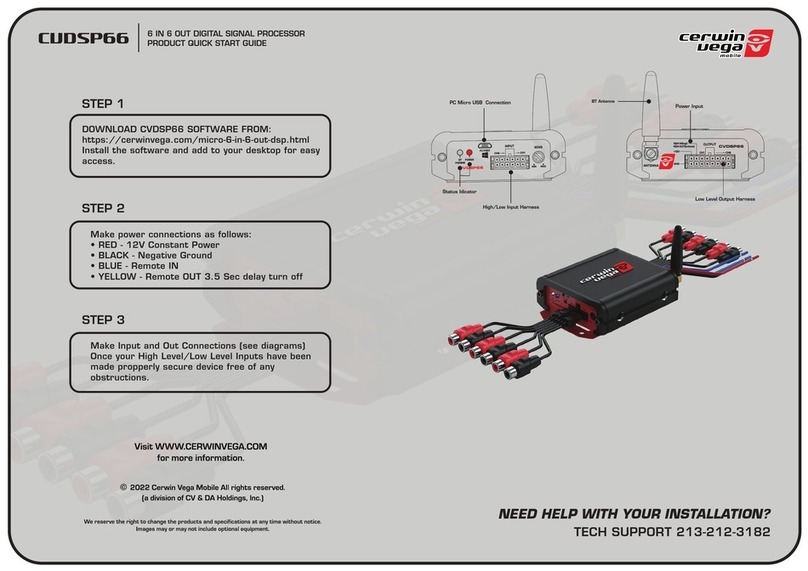
Cerwin-Vega
Cerwin-Vega CVDSP66 quick start guide

Palmer
Palmer The Junction PDI-09 manual
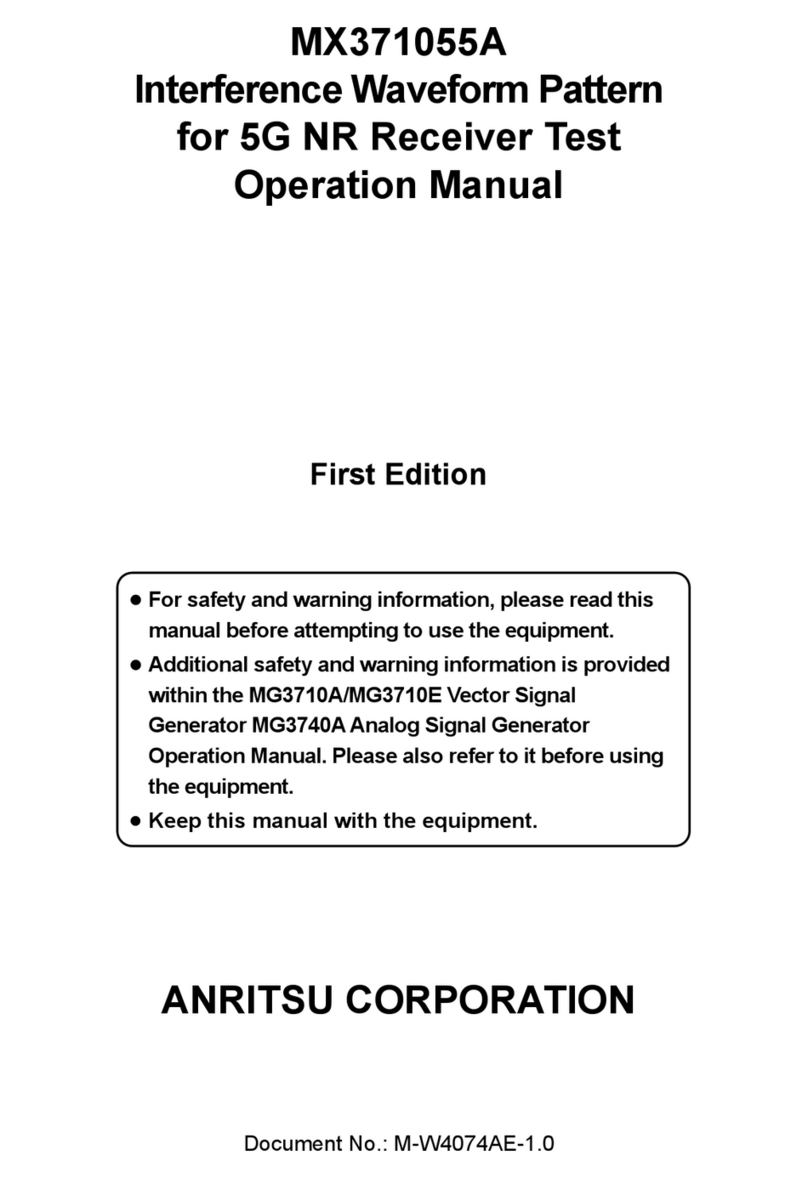
Anritsu
Anritsu MX371055A Operation manual
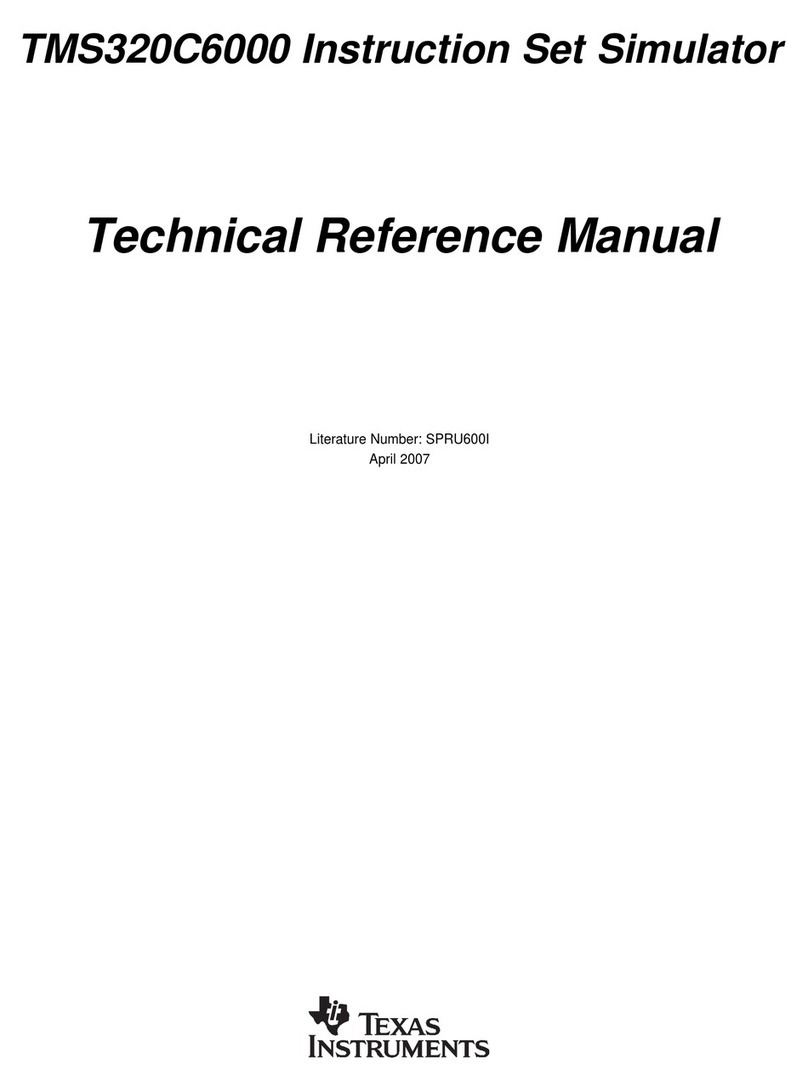
Texas Instruments
Texas Instruments TMS320C6000 DSP Technical reference manual
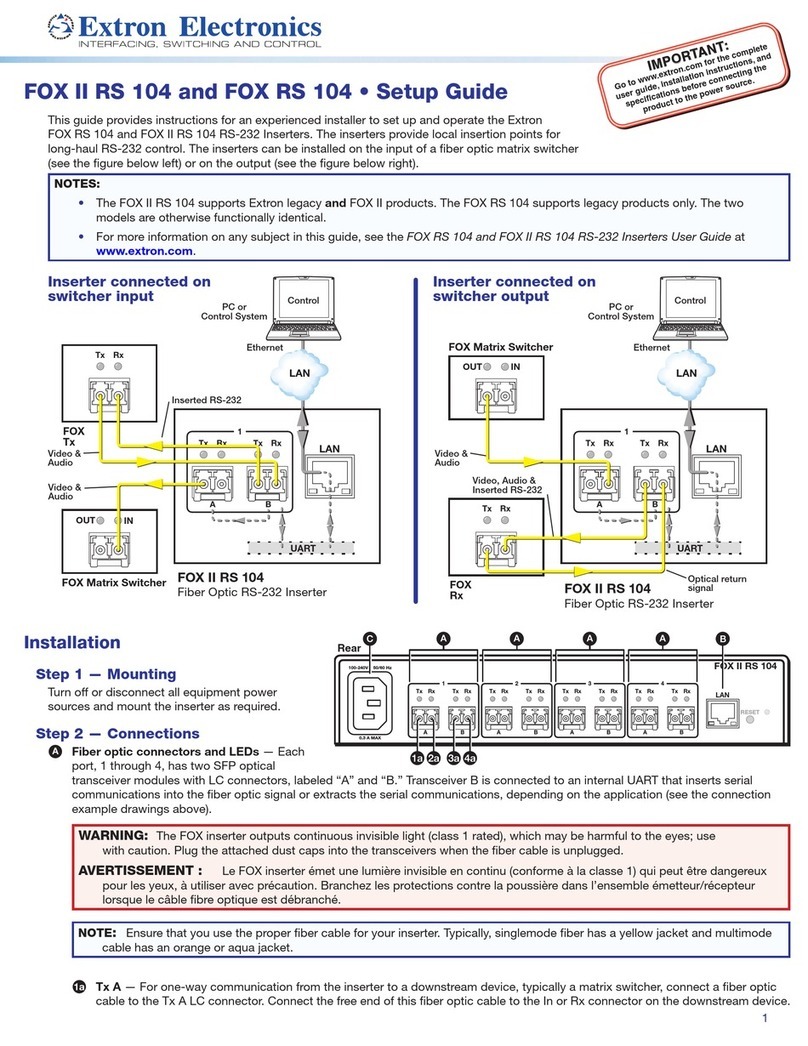
Extron electronics
Extron electronics FOX II RS 104 Setup guide
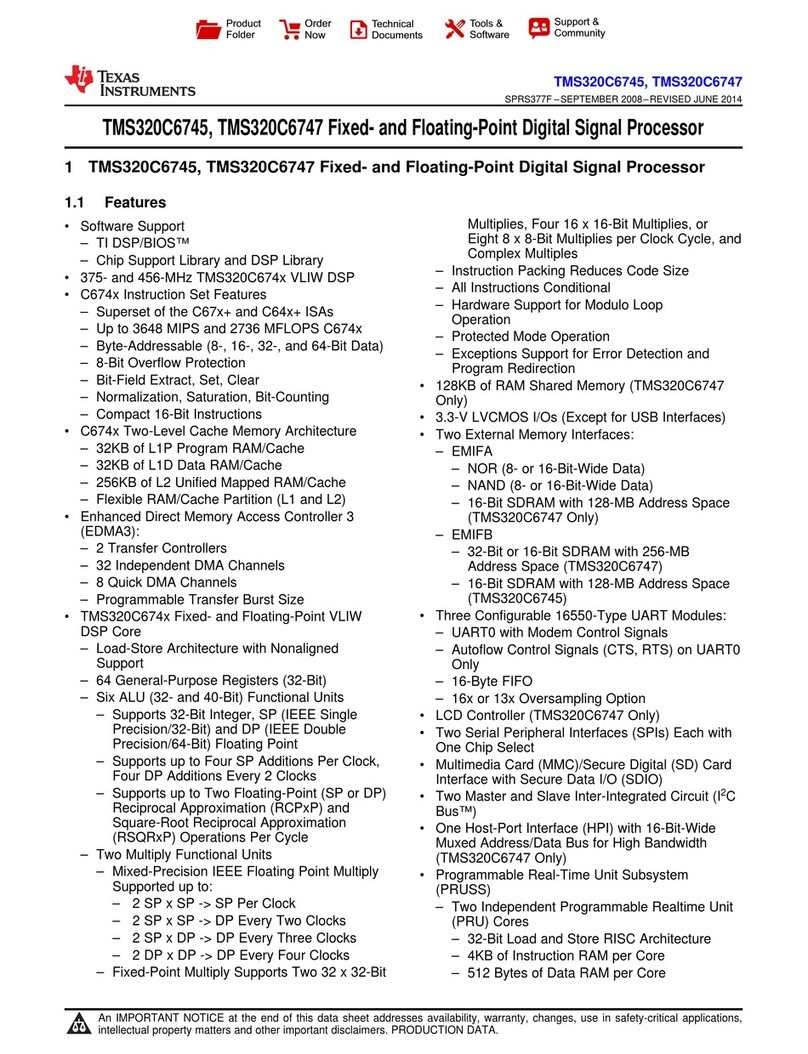
Texas Instruments
Texas Instruments TMS320C6745 DSP manual



